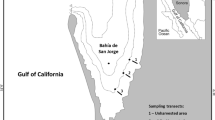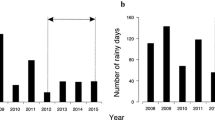Abstract
Crab pots were used to sample a population of Scylla serrata (Forskal) in an estuarine area in Queensland, Australia. Pots were laid 100 m apart at fixed positions for 4 d each month for 1 yr (April 1980–June 1981). Data from recapture of tagged crabs showed that males larger than 140 mm carapace width and females larger than 150 mm had a higher capture probability than did smaller crabs; thus size-frequency distributions based on crab-pot captures are biased. Spacing trials showed that pots positioned 50 m apart fished competitively but that there was no difference in catch between those placed 100 and 200 m apart. Catch distribution indicated that the presence of a crab in a pot reduced the probability of further captures. Temperature and incidence of recently moulted crabs accounted for 66% of variation in monthly catches. Catch-per-unit-effort (CPUE) data can be used as a measure of relative abundance of adults if allowance is made for temperature and the incidence of moulting. The capture-mark-release-recapture method for making population estimates was tested but it is concluded that, because of cost and bias in collecting techniques, it cannot be recommended as a technique for studying S. serrata.
Similar content being viewed by others
Literature Cited
Burnham, K. P. and W. S. Overton: Estimation of the size of a closed population when capture probabilities vary among animals. Biometrika 65, 625–633 (1978)
Burnham, K. P. and W. S. Overton: Robust estimation of population size when capture probabilities vary among animals. Ecology 60, 927–936 (1979)
Caddy, J. F.: Some considerations underlying definitions of catchability and fishing effort in shellfish fisheries, and their relevance for stock assessment purposes. Manuscr. Rep. Fish. mar. Serv. Can. 1489, 1–24 (1979)
Chittleborough, R. C.: Environmental factors affecting growth and survival of juvenile western rock lobsters Panulirus longipes (Milne Edw.). Aust. J. mar. Freshwat. Res. 26, 177–196 (1975)
Drach, P.: Mue et cycle d'intermeu chez les Crustaces Decapodes. Annls Inst. océanogr., Monaco (N.S.) 19, 103–391 (1939)
Heasman, M. P.: Aspects of the general biology and fishery of the mud crab Scylla serrata (Forskal) in Moreton Bay, Queensland, 506 pp. Ph.D. thesis, Zoology Department, University of Queensland 1980
Hill, B. J.: Abundance, breeding and growth of the crab Scylla serrata in two South African estuaries. Mar. Biol. 32, 119–126 (1975)
Hill, B. J.: Effects of temperature on feeding and activity in the crab Scylla serrata. Mar. Biol. 59, 189–192 (1980)
Jolly, G. M.: Explicit estimates from capture-recapture data with both death and dilution—stochastic model. Biometrika 52, 225–247 (1965)
Manly, B. F. J. and M. J. Parr: A new method for estimating population size, survivorship, and birth rate from capture-recapture data. Trans. Soc. Br. Ent. 18, 81–89 (1968)
Miller, R. J.: Design criteria for crab traps. J. Cons. int. Explor. Mer. 39, 140–149 (1980)
Morgan, C. R.: Aspects of the population dynamics of the western rock lobster, Panulirus cygnus George. II. Seasonal changes in the catchability coefficient. Aust. J. mar. Freshwat. Res. 25, 249–259 (1974)
Morrissy, N. M.: The influence of sampling intensity on the “catchability” of marron, Cherax tenuimanus (Smith) (Decapoda: Parastacidae). Aust. J. mar. Freshwat. Res. 26, 47–73 (1975)
Morrissy, N. M. and N. Caputi: Use of catchability equations for population estimation of marron, Cherax tenuimanus (Smith) (Decapoda: Parastacidae). Aust. J. mar. Freshwat. Res. 32, 213–225 (1981)
Otis, D. H., K. P. Burnham, G. C. White and D. R. Anderson: Statistical inference from capture data on closed animal populations. Wildl. Monogr., Jefferson City 62, 1–135 (1978)
Passano, L. M.: Molting and its control. In: The physiology of Crustacea, Vol. 1. Ed. by T. H. Waterman. New York: Academic Press 1960
Seber, G. A. F.: The estimation of animal abundance and related parameters, 506 pp. London: Griffin 1973
Sinoda, M. and T. Kobayasi: Studies on the fishery of zuwai crab in the Japan Sea—VI. Efficiency of the Toyama Kago (a kind of crab trap) in capturing the beni-zuwai crab. Bull. Jap. Soc. scient. Fish. 35, 948–956 (1969)
Taylor, L. R.: Aggregation, variance and the mean. Nature, Lond. 189, 732–735 (1961)
Author information
Authors and Affiliations
Additional information
Communicated by G. F. Humphrey, Sydney
Rights and permissions
About this article
Cite this article
Williams, M.J., Hill, B.J. Factors influencing pot catches and population estimates of the portunid crab Scylla serrata . Mar. Biol. 71, 187–192 (1982). https://doi.org/10.1007/BF00394628
Accepted:
Issue Date:
DOI: https://doi.org/10.1007/BF00394628




